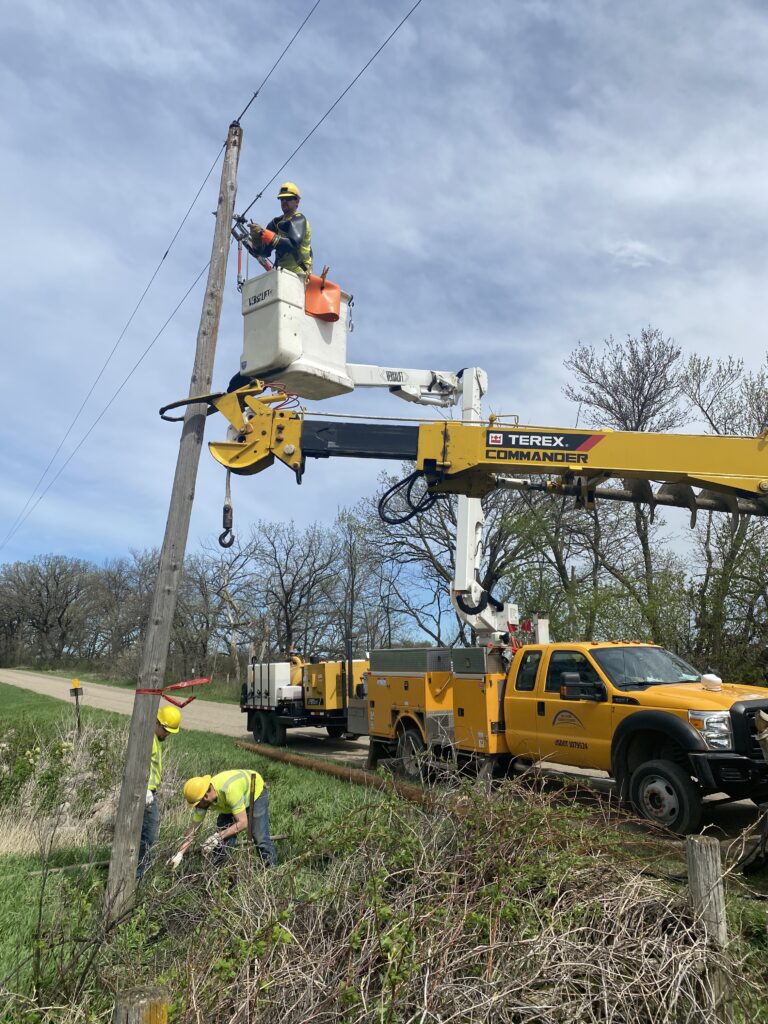A LINEWORKER’S TIMELINE: RESTORING A POWER OUTAGE
“How long is it going to take?” Those are familiar words to all who work in the electric industry. It’s a phrase line workers at McLoed Co-op Power have been asked thousands of times. It’s the first thing people think when the lights go out. It doesn’t take long sitting in the dark to realize how dependent we are on electricity. But what does it take to get those lights back on? Why does it sometimes take so long?

Most people will never get to experience or witness the work that goes into ending outages. So we interviewed Brad Hundt, a McLeod Co-op Lineman for over 15 years, to share some of the story from his perspective behind the scenes.
THE OUTAGE CALL: A line worker may find themselves receiving a call from dispatch at the most inconvenient times—whether it’s moments after getting home or in the dead of night— prompting a swift response.
When the dispatcher calls, they pass along the power outage location, number of members who are impacted, and any additional information about the outage or safety concerns. “The first thing I do is take a few minutes to look at our mapping system from the app on our phones,” shared Brad. “This helps me answer a few questions like, where is the power source? Is it overhead or underground? Will we need any specific equipment? At this point, I also take the time to read the comments that have been called in to our dispatch to help identify a possible cause for the outage. I’m hopeful to find information that can pinpoint the location of an issue.”
With 30 minutes or less to report to the headquarters line workers move quickly. After taking some notes from dispatch and a quick assessment, they grab any personal items they need and hit the road. “On the drive to the shop I’m getting mentally prepared for the job running through what is ahead and what I need to do.” Tips from our members that can be helpful are reporting things like hearing a loud bang and where they heard it, if there is a tree branch on their power line, an accident (car vs pole/farm equipment), and so forth.
TRAVEL TIME: When line workers arrive at the McLeod Co-op Power Headquarters it typically takes only 15 minutes for the responding team of two to prepare the trucks, run a safety check, load up and hit the road. “Before pulling out of the shop, we double check the outage location and any additional details that may have come in about the outage. As we drive, we make sure as a team we are on the same page and talk through our plans for arriving on scene. A lot of problem solving happens on the road.”
Location and weather are significant factors in an outage response time. McLeod Co-op’s service territory spans approximately 965 square miles. Outages can be anywhere from 5 minutes to an hour away and bad weather can make travel times even longer.
ARRIVAL: Once line workers arrive at the scene of the power outage, the first order of business is always to assess the situation and locate the cause of the outage, which could be anything from a blown fuse to a massive storm event or a car accident. “That initial assessment includes a visual assessment of the environment and the conditions to addressing hazards, bystanders, and in some case coordinating with emergency services and dealing with public relations personnel. There are a lot of variables that have to be considered when a crew arrives,” Line Superintendent Emerson Brady added. “If members feel they have information that will help us, it’s best to call our dispatch line. They will relay anything important, which allows us to stay focused on the work in front of us and restore power faster.”
PATROLLING: Patrolling is what comes next. Patrolling is the act of visually inspecting everything down the line from the source of the outage. The last thing we would want to do is re-energize a power line that has been compromised and possibly endanger the public or cause a larger outage.
“In a rural setting, most of our patrolling is done from the truck. In a residential area, we may be on foot, walking through backyards,” noted Brad. “This can often be confusing for members as they might see us come and go. It’s important to understand that there is a process at work.”
ADDRESSING THE CAUSE: With time and effort, line workers find the cause of the outage and establish a plan to restore power. At this time additional crews are called in for support if needed. “If it is a smaller issue, we often can take care of it on the spot with one of our extendable fiberglass sticks to remove a branch, animal, or a piece of broken equipment.
If it’s a larger issue like a broken pole or wires on the ground, we then must install a “ground set.” A ground set is a series of wires that we install on the power line that will short the circuit to the ground, making the power lines safe for us to proceed with our work. With larger issues, we will often cut the power lines apart so we can re-energize as many members as possible by isolating the issue further down the line.”
FACING THE ELEMENTS: Conditions have a significant impact in how long it takes to restore power. While most outages are routine, responding during a rainstorm or blizzard involves facing challenging conditions.
During a storm, visibility is usually the biggest concern. “The elements can create a very harsh working environment. Many times the lines are swaying in the wind, there are flashes of lightning all around us, and rain is pelting us in the face. The interplay of your vision, the darkness, and the reflections lights in the rain can be disorienting,” Brad detailed. “You get this incredibly eerie feeling sometimes when the atmosphere is charged with the buzzing of static in the air.” Line workers will often comment about how responding to an outage in a storm evokes a sense of adrenaline, making them feel alive, but it’s incredibly important that they follow protocol set by the Co-op and rely on their instincts to determine when it’s safe to work.
“When we have those long-extended outages, one safety procedure we have is that we are never allowed to work more than 16 hours straight. And when that timeframe is closing in, it’s really tempting to squeeze in just one more outage. But you just never know what you’re going to get into, and I have to remind myself that I can only restore one outage at a time.”
RESTORATION: Restoring power involves a coordinated effort. Once the cause is identified and addressed, crews work diligently to repair or replace damaged components. This often includes repairing downed power lines, fixing transformers, or replacing faulty equipment. The restoration process prioritizes critical infrastructure and densely populated areas. As repairs progress, power is gradually restored to affected members, bringing relief in the wake of disruption.
RETURN TO THE SHOP: After successfully restoring power, line workers return to the shop to restock and prepare for the next call. Documentation and reporting are crucial, and debriefing sessions are typically held the following morning to share insights and takeaways as a team.
SACRIFICES AND REWARDS: Line workers and their families often make significant sacrifices for their responsibilities during outages. They miss all kinds of things from birthday parties and Christmas celebrations to deer hunting and family game nights. “It’s really a family commitment. I’ve got a wonderful wife and three kids that give up a lot when I’m on call. I’ve missed baseball games and all kinds of family activities,” shared Brad. “It takes a toll, many times my wife will be at home lying awake with worry until I come home safe.”
Despite the unpredictable schedule and the sacrifice, line workers find reward in restoring power, serving their communities, and taking pride in their work. The understanding and support of community members make the commitment worthwhile.
In the world of linework, the timeline of a power outage is a carefully orchestrated process, demanding dedication, skill, and a commitment to service. Line workers like Brad continue to navigate these challenges, ensuring that when the lights go out, they are there to bring them back on.
“I got started in this career because I knew I would enjoy working outdoors, get to drive around in a cool truck and make a good living. But after you get into the field it becomes more than that,” shared Brad. “Responding to outages is exciting and challenging. There are so many unknowns, you have to think on your feet, and its empowering. Being able to turn the power back on for families and businesses brings me great satisfaction and a strong sense of purpose. I’m proud of the work I do to serve the people in my community.”
